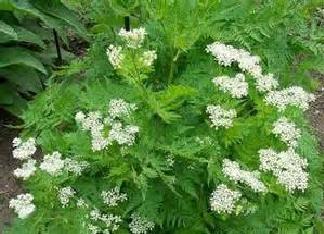Anise (Aniseed) انیسون
DESCRIPTION
Pimpinella anisum, also called aniseed, is a flowering plant in the family Apiaceae native to the eastern Mediterranean region and Southwest Asia. Its flavor his similar to some other spices, such as star anise, fennel, and liquorice. Anise also is known as aniseed, and sweet cumin.
Anise flowers are born in umbels like Queen Anne’s Lace. The seeds are the useful part of the plant and resemble caraway and carrot seeds. It is easy to grow anise and the feathery leaves are borne on slightly purple stems. The plant, which grows just under 2 feet tall, requires a warm growing season of at least 120 days.
Anise is widely cultivated in many European and Asian countries but has not been an important crop in the United States.
Anise is an annual herb that grows 0.3 to 0.6 m and is cultivated widely all over the world. The flowers are yellow, compound umbels and its leaves are feather shaped. The greenish-brown, ridged seeds are used for food or the drug. They are harvested when ripe in autumn. Aniseed has an a sweet “licorice-like” aromatic taste, which has led to the traditional use of anise oils in licorice candy.

HISTORY
In Biblical times, anise was so highly prized that it was often used for tithes, offerings and payment of taxes in Palestine. It is mentioned in both the gospels of Luke and Mark.
Many of the well known Greek and Roman authors, including Dioscorides, Theophrastus, Pliny and Paladus spoke of the cultivation and different uses of anise.
Albertus Magnus (1193/1206 – 1280), a priest who was perhaps the most widely read author of his time, speaks highly of anise.
Despite being cultivated for at least 2,000 years, there has been very little development of the improved varieties
USES
The seeds, once crushed, yield an aromatic oil that is used in soaps, perfume and also in potpourris.
Anise has a history of use as a spice and fragrance. It has been cultivated in Egypt for at least 4,000 years and recordings of its diuretic use and treatment of digestive problems and toothache are seen in medical texts from this era. In ancient Greek history, writings explain how anise helps breathing, relieves pain, provokes urine, and eases thirst. The oil has been used commercially since the 1800s. The fragrance is used in food, soap, creams, and perfumes. Anise often is added to licorice candy or used as a “licorice” flavor substitute. It is a fragrant component of anisette liqueur. Anise is used as a flavoring in all food categories including alcohols, liqueurs, dairy products, gelatins, puddings, meats, and candies. It is sold as a spice, and the seeds are used as a breath freshener.
MEDICINAL USES
Anise (Pimpinella anisum) is native to the Middle East and has been used as a medicine and as a flavor for medicine since prehistoric times. Ancient Romans hung Anise plants near their pillows to prevent bad dreams. They also used Anise to aid digestion and ward off epileptic attacks. Colonists in the New World used it as a medicinal crop too.
Anise is the dried ripe fruit of the herb Pimpinella anisum. The crescent shaped seeds are unmistakably identified by their distinctive licorice-like flavor.
Anise was given the nickname, Solamen intestinorum, the comforter of the bowels.
Germans believed so strongly in the medicinal value of anise that during the 1800s they often flavored their household bread with whole aniseed.
